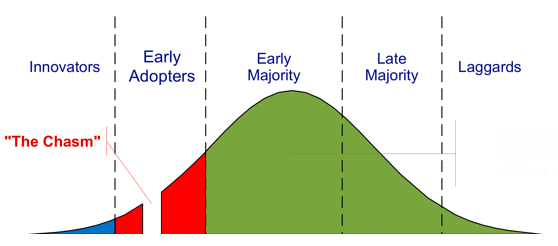 I’m not going out on a limb in stating that many in marketing have probably heard of the Law of Diffusion of Innovation. He didn’t create it but Simon Sinek brought it to life for me.
I’m not going out on a limb in stating that many in marketing have probably heard of the Law of Diffusion of Innovation. He didn’t create it but Simon Sinek brought it to life for me.
The birthing of the Law of Diffusion of Innovation over 50 years ago, is credited to a professor from Iowa State University named Everett Rogers. Rogers’ work underscored the fact that innovation, any innovation, no matter how good it is, can’t be successfully adopted without social acceptance and behavioral change.
While Rogers’ tenet is quite compelling, Sinek’s video allowed me to understand this much more clearly. Once I watched his now famous YouTube video the lightbulbs went off in my head and it forever changed the way I conduct business.
The model for the Law of Diffusion of Innovation is illustrated by a bell curve and it details who we are and where we fall in the cycle of the adaptation of ideas.

On this curve, 2-3% of our population are innovators, 13.5% are early adopters, 34% are early majority, 34% are late majority, and 16 % are laggards. Where do you see yourself being?
It’s 2014. Social media has been in full bloom for quite some time. New platforms, devices and ideas flow daily.
Are you up to speed on Snapchat? Have a great handle on how social television is becoming the way we will watch our favorite shows? Do you know that concert tours are becoming increasingly marketed by social media only? Are you seeing where the wearable market is taking us? Or are you just now deciding that Twitter works for business?
I’ve always been a bit of a risk taker so I guess I’m someone who likes to innovate or take early adoption of an idea. Sometimes those risks can be detrimental, but more often than not, those risks have afforded me the ability to be quicker to market than my competitors.
It’s actually not that hard to differentiate your business position when you’re on the front end of the bell curve of the diffusion graph.
The key is to find people who believe what you believe. You see, as Sinek has said in his video:
“the early majority will not try something until someone else has tried it first.”
This is pretty much what most seminars, conferences, online chats etc are predicated upon. It’s usually some keynote speaker or panel bringing their harvest to the masses and saying “hey look…now that I’ve kind of figured something out, I’m willing to discuss it with the rest of you (or sell the idea to the rest of you) so that all of you (early or late majority members) can now partake in and go forth and implement.”
Which if you’re doing business in the social media marketplace and relying on the info you hear at most conferences and seminars puts you smack dab in the middle of the herd. You’re already too late to the party. In regards to the social and digital time that we live in, you need to adjust your position on the bell curve above to really differentiate.
There are leaders, and then there are those who lead. Leaders hold a position of power, or authority. But those who lead, inspire us. We follow those who lead, not because we have to, but because we want to. We follow, not for them, but for ourselves. It’s those that start with “why” that have the ability to inspire those around them, or find others who inspire them.
Remember, that the next time you go to a seminar or conference or participate in an online chat. More than likely you’re hearing yesterday’s weather. It doesn’t make you a dunce or a bad business person. It just puts you in that undesirable position on the curve.
At some point in our business (and personal) lives we fall in various positions along that bell curve. What I’m pointing out in this article is that in regards to social media, you may want to nudge yourself more to the left end of the graph.
In social media marketing I’m not sure there’s safety in numbers. Unless you’re one who likes said safety.
In that regard, I guess you’re right where you want to be.




Join the discussion 2 Comments